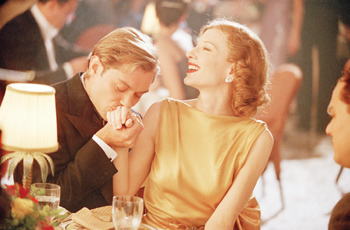![[Metroactive Movies]](/movies/gifs/movies468.gif)
[ Movies Index | Show Times | Silicon Valley | Metroactive Home | Archives ]

Photograph by Andrew Cooper/Miramax Stars' Night Out: Errol Flynn (Jude Law) cavorts with Katharine Hepburn (Cate Blanchett) in 'The Aviator.' Soap Opera In 'The Aviator,' Martin Scorsese cleans up millionaire daredevil and madman Howard Hughes THERE ARE probably five good movies to be made about the life of Howard Hughes, and The Aviator is about half of one of them. Martin Scorsese's idealized version of the life of Hughes takes place between 1929 and 1947. Scriptwriter John Logan (Gladiator) adapted the manifold life of the great American millionaire/pilot/producer/madman by restaging Hughes' story as a series of remakes of classic Hollywood movies. Hughes' romance with Katharine Hepburn (Cate Blanchett) is performed as Bringing Up Baby, with a dizzy overbred society gal romantically overwhelming a gawky inventor (Leonardo DiCaprio as Howard Hughes as Henry Fonda). When she takes him home to her estate in Connecticut, the Hepburn family members are presented as a cattier version of the Vanderhofs in You Can't Take It With You. Hughes' final confrontation with Sen. Brewster (Alan Alda) over the air routes for TWA is restaged as Mr. Smith Goes to Washington. On the sidelines, Alec Baldwin (in the manner of Lionel Barrymore) plays Juan Trippe of Pan Am, trying to thwart Hughes' hard-working little guy. The millionaire's 1947 appearance in front of the Senate is the movie's finale. Even if the historical facts aren't straight, Hughes' last stand in Washington, D.C., is accurate in style. As Hughes' biographers Donald L. Bartlett and James B. Steele note, "The Hughes who emerged at those hearings—outgoing, vocal, almost extroverted—had never been seen before and would never be seen in public again." Scorsese's knowledge of old-time film makes this holiday hash flavorable. He brings in film-geek innovations, such as an antique bluey/orangy color process to suggest Los Angeles's earlier years. The re-creation of Hughes' extravagant dogfight epic, Hell's Angels, serves up the most thrilling aerial moments from that early blockbuster. Biplanes buzz Hollywood Boulevard for the Grauman's Chinese premiere, which goes from splendor to squalor fast. A Day of the Locust crowd squeezes in on Hughes as he crunches a litter of broken glass from the exploding flashbulbs. The afterparties are swank and brassy. Scorsese serves up Cocoanut Grove nightclubbing, with Jude Law picture-perfect as a table-hopping Errol Flynn. (A casting strategy that works better than Kate Beckinsale as Ava Gardner, and much better than Gwen Stefani as Jean Harlow.) And the midpoint crash of Hughes' XF-11 is a rousing violent spectacle, with the plane tearing into the tiles on the roofs of Beverly Hills. Hughes' "Rosebud" is a tin soap container he carries with him at all times. Both of Hughes' parents dropped dead suddenly, and he had good reason for his hypochondria, but Logan doesn't get into that. Chilly scenes straight out of Kubrick are used to portray Hughes' agonies in public washrooms. It's the beginning of his first breakdown and self-imposed quarantine in a screening room. Scorsese portrays the collapse with Hughes raving amid snowdrifts of spent Kleenex. A projector plays and replays The Outlaw, printing shadows of saguaros on Hughes white flesh. He lines up bottles of milk and bottles of piss and recites the alphabet. We all knew about Jane Russell's bra and the Spruce Goose—did Hughes invent performance art? DiCaprio is still markedly a juvenile actor. However, this wizening youthfulness gives Scorsese's lead actress carte blanchett to mother him. Blanchett's Kate is an unmitigated treat. It's not so much that she has the look of Hepburn as the mannerisms, the air of loneliness under the constant gab. She looks frank and appealing, just like that other Kate. And we believe the parts of her that Hepburn didn't show onscreen—the vanity and naiveté. Blanchett's Hepburn is soft in places we're hard and hard in places we're soft, as F. Scott Fitzgerald said of the rich. Despite Blanchett, The Aviator leaves an aftertaste. Live long enough, and you will live to see Howard Hughes presented onscreen as a champion of the people. A boondoggler who fleeced the U.S. government with one hand and begged for tax relief with the other, Hughes was the very model of the modern defense contractor. Courageous as he was in the air, he was indecisive on earth. He ran RKO into the ground. He sat on Howard Hawks' Scarface for several decades, forbidding it to be viewed. On his own volition, Hughes hatched turkeys like Vendetta, Jet Pilot and The Conqueror; the last is a movie that he watched hundreds of times in his dotage. He was a racist, refusing to use the same screening room the cast of Goldwyn's Porgy and Bess once sat in. The feel-good touches that Logan and Scorsese put on this monster-man's life aren't a triumph of cinema making. They're a triumph of plutocrat-worship, and it comes out right at an age when the American people are at their most inclined to prefer legend to fact.
The Aviator (PG-13; 169 min.), directed by Martin Scorsese, written by John Logan, photographed by Robert Richardson and starring Leonardo DiCaprio and Cate Blanchett, opens Friday valleywide.
Send a letter to the editor about this story to letters@metronews.com. [ Silicon Valley | Metroactive Home | Archives ]
|
From the December 15-21, 2004 issue of Metro, Silicon Valley's Weekly Newspaper.
Copyright © Metro Publishing Inc. Metroactive is affiliated with the Boulevards Network.
For more information about the San Jose/Silicon Valley area, visit sanjose.com.